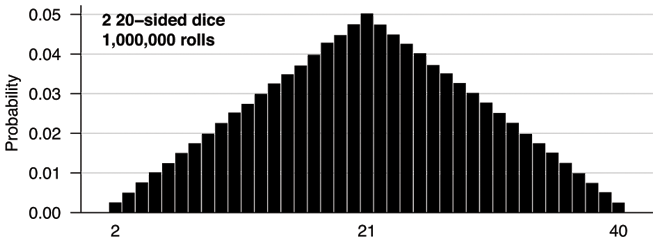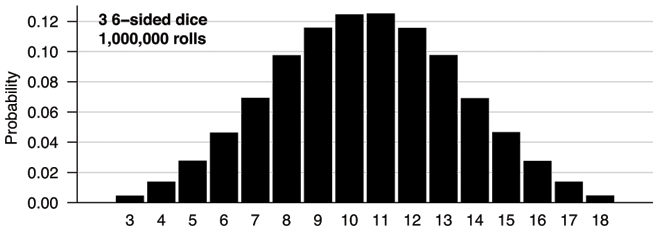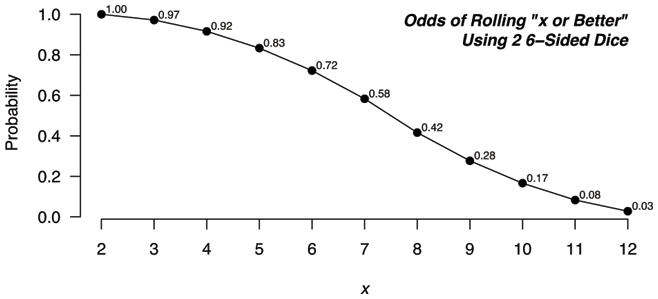posted March 16 2011
probability for the common dungeon master
While wandering around PAX East’s gargantuan Expo Hall, I found myself inexplicably drawn, over and over, to the Chessex booth. This is a company whose sole product is dice. Don’t be fooled by their awful website, these people are serious about their product. The booth was bordered by bin after bin of dice, meticulously arranged by color and number of sides. They had dice of every hue, material, size, and shape you could possibly imagine, and many that you couldn’t. I picked up a set of 6-sided dice labeled in Roman numerals for the Tall One, as well an odd pair whose sides were labeled as noun/verb/adjective and who/what/when/where/why/how. On dice! Also one with some mathematical symbols on it. And two 6-sided dice that I just really, really liked the look of. It was at this point that I finally managed to wrench myself from Chessex’s candy-colored grasp, gazing in wonder at the hive-like activity of nerds picking out dice, like bees pollinating a field of flowers.
Did I need these dice? No, of course not, but that’s hardly the point, and at about 50 cents apiece, it’s not like I’m risking a plunge into massive dice debt. My recent purchases have, however, gotten me thinking about dice and basic probability. Given a roll of two dice, how likely are you to get a particular value? What patterns do these numbers obey? Just how lucky is 7? If the guy running an RPG tells you that you need “a 6 or better” to win this encounter, just how easy or hard is that? I’m not an expert in probability or even a mathematician, but I thought it’d be fun to investigate these questions. Dice and data come from the same Latin root, after all.
I can remember playing a board game with my dad, maybe Monopoly, maybe Parcheesi, where he decided to drop some Dad Knowledge on me: 7 is the most common roll of the dice. Roll one die, and no matter what number comes up, there’s going to be a number on the second die that can make the two sum up to 7. This is not true of any other combined roll. If I’m trying to roll a 6, for whatever reason, and 6 comes up on the first die, I’m guaranteed to overshoot. So, given a pair of 6-sided dice, 7 is the most common roll. But how common? If I were a proper mathematician, I’d squint really hard and pull an elegant formula from the depths of my brain. But I’m a psychologist and statistician, and increasingly, we prefer R. So I’ve used R to simulate one million rolls of a pair of 6-sided dice. Here’s the resulting distribution of rolls:
 It turns out that these rolls follow a perfectly triangular distribution. I can already hear the statisticians in the audience furrowing their brows, and no, these numbers do not follow the more common normal distribution. The odds do not follow a bell curve, but rather, your odds of rolling a particular number decrease linearly from the peak of 7. This is true of all two-dice rolls, and if you don’t believe me, here’s a simulation of two 20-sided dice:
It turns out that these rolls follow a perfectly triangular distribution. I can already hear the statisticians in the audience furrowing their brows, and no, these numbers do not follow the more common normal distribution. The odds do not follow a bell curve, but rather, your odds of rolling a particular number decrease linearly from the peak of 7. This is true of all two-dice rolls, and if you don’t believe me, here’s a simulation of two 20-sided dice:
 Boom. Triangle. Based on these simulations, we can extrapolate some rules for the probability of rolling a particular number. Given a pair of n-sided dice, the most common roll will be n + 1. The odds of this roll are 1/n. The odds of the other rolls decrease linearly as you move away from the peak, bottoming out at a probability of 1/n2 at the ends. So using a set of 6-sided dice, the most common roll, 7, has a one in six chance of being rolled. Rolls of 2 or 12 have just a one in thirty-six chance of appearing.
Boom. Triangle. Based on these simulations, we can extrapolate some rules for the probability of rolling a particular number. Given a pair of n-sided dice, the most common roll will be n + 1. The odds of this roll are 1/n. The odds of the other rolls decrease linearly as you move away from the peak, bottoming out at a probability of 1/n2 at the ends. So using a set of 6-sided dice, the most common roll, 7, has a one in six chance of being rolled. Rolls of 2 or 12 have just a one in thirty-six chance of appearing.
The statisticians in the audience are probably starting to feel a longing for their beloved normal distribution. Luckily for them, the distribution of possible values starts to approximate a normal distribution as more dice are added. Here’s the simulation for one million rolls of three 6-sided dice:
 This is definitely the familiar bell curve, albeit a slightly platykurtic one. Great word, right? Platykurtic. It means that the peak is slightly flatter than you’d expect compared with a perfect bell curve.
This is definitely the familiar bell curve, albeit a slightly platykurtic one. Great word, right? Platykurtic. It means that the peak is slightly flatter than you’d expect compared with a perfect bell curve.
One last thing. I’ve often played tabletop games where I’m told that I need to roll some number or better, for instance, “You need a 7 or better to win this encounter.” Based on the distributions we’ve covered so far, it’s a simple matter to transform them into game-appropriate cumulative functions:
 You have a 100% chance of rolling a 2 or better (duh), whereas you have just a 3% chance of rolling a 12. The curve is nonlinear, a fact which I doubt most DMs ever keep in mind. So if I’m the DM and I want my party to have a 50/50 chance of winning the battle using their 6-sided dice, the roll they need is 7.5 or better. Obviously that’s not possible, so the real question is whether I want the roll to be slightly easier (7 or better) or slightly harder (8 or better). What I find interesting is that 8 feels like a fairly high roll, but in fact, you’ll roll an 8 or better 42% of the time.
You have a 100% chance of rolling a 2 or better (duh), whereas you have just a 3% chance of rolling a 12. The curve is nonlinear, a fact which I doubt most DMs ever keep in mind. So if I’m the DM and I want my party to have a 50/50 chance of winning the battle using their 6-sided dice, the roll they need is 7.5 or better. Obviously that’s not possible, so the real question is whether I want the roll to be slightly easier (7 or better) or slightly harder (8 or better). What I find interesting is that 8 feels like a fairly high roll, but in fact, you’ll roll an 8 or better 42% of the time.
If you’re rolling a single die the odds of getting any particular number are uniform, assuming the die is fair. But the minute you start messing around with multiple dice, the underlying distribution changes and begins to approximate the probabilities of real-world statistics. The more you know, right?